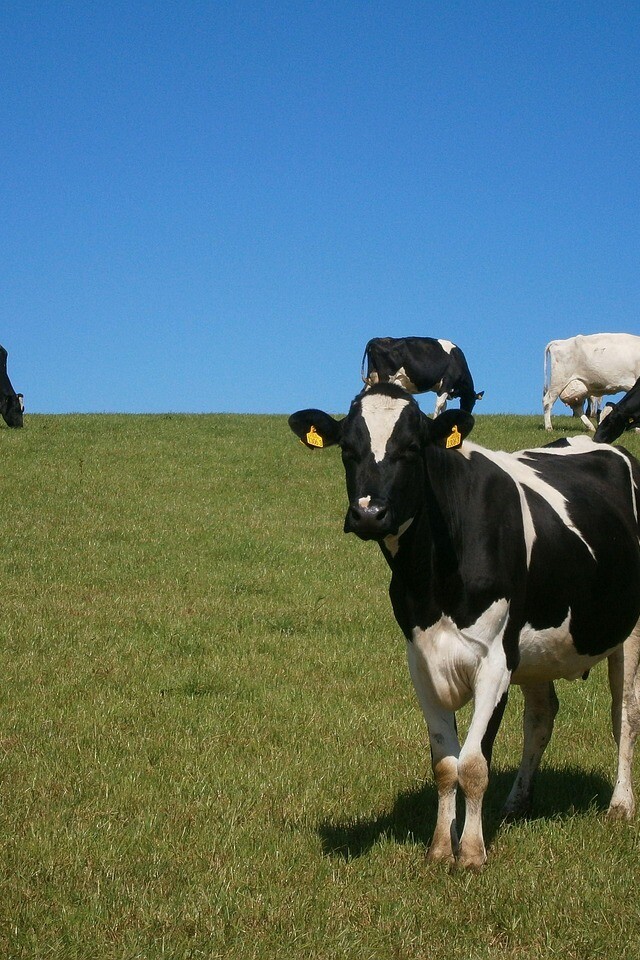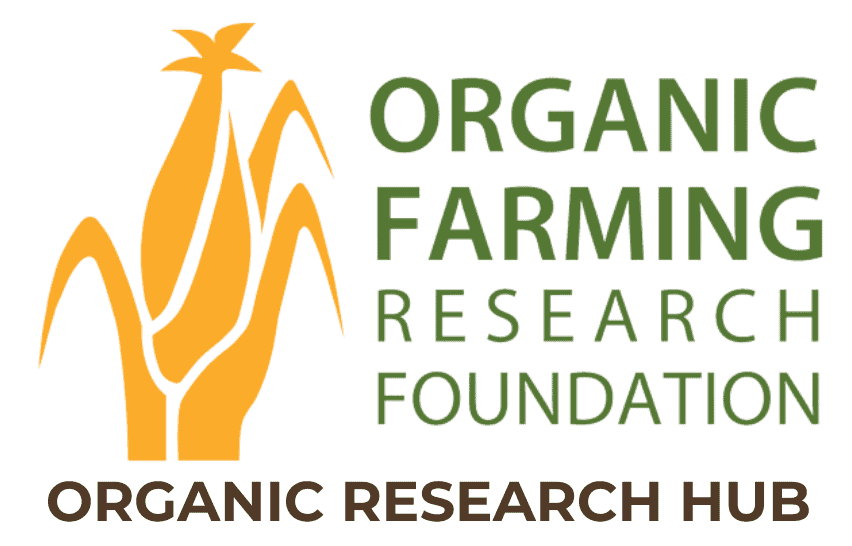Advancing Grass-fed Dairy: A Whole Systems Approach to Enhancing Productivity, Quality, and Farm Viability in the US
Project Director: Heather Darby, University of Vermont
Project Overview
Due to strong consumer demand for grass-fed organic dairy products, many organic dairy farmers are attempting the transition towards a 100% grass-fed system. However, these producers face significant challenges, including pasture quality, herd health, milk production and quality, net economic returns, and a lack of science-based practical information.
The goal of this project was to identify critical grass-fed dairy management practices to optimize herd and environmental health, economic viability, milk quality, and marketing success. The researchers addressed knowledge gaps through benchmarking surveys, on-farm studies of soil and nutrient management for forage quality, sensory analyses of grass-fed milk flavor components, and research into consumer expectations. The project has built a robust knowledge network among organic dairy farmers, processors, and service providers.

Farmer Takeaways
- Grass-fed dairy operations have higher forage and pasture requirements than conventional, grain-based dairy operations. To accommodate the dietary needs of grass-fed dairy cows, herd sizes can be adjusted to provide ~7 acres/cow, or supplemental forage can be purchased/imported.
- 100% grass-fed dairy operations may result in a net nutrient deficit over time, so additional nutrient inputs (i.e. fertilization, imported grain/forage) are recommended.
- Healthy soil, sound grazing management, and high-quality mixed-species forages are critical for animal health, milk production and quality, and environmental stewardship.
Project Objectives and Approach
Understand the economic and production metrics for grass-fed dairy systems across the United States
The researchers conducted a national survey of grass-fed organic dairy producers (164 respondents) to establish benchmarks for herd size, farm acreage, and milk production. A subset of 21 farms participated in a more detailed assessment of farm economics including production costs and gross and net proceeds from milk sales over a three year period.
Understand nutrient cycling dynamics and the subsequent impacts on forage crop production, soil health, dairy production, and livestock health
Whole-farm nutrient balances* were calculated for two organic dairies that fed purchased grain and forage, two grass-fed dairies with purchased fertility (poultry litter), and two grass-fed dairies with no purchased fertility. Fertilizer trials were conducted on pasture and hayland.
- *An agricultural nutrient balance test involves evaluating the net movement of nutrients into and out of a system. Nutrient inputs (i.e. purchased feed and fertilizer) and outputs (i.e. forage crops, livestock, dairy products, manure) are compared to determine whether nutrients in the system are accumulating, remaining constant, or depleting over time.
Milk urea nitrogen (MUN), an index of protein use efficiency and N excretion into the environment, was measured monthly for one full year on five farms in Vermont and New York. MUN and herd health parameters were related to pasture species and management practices.
Investigate the impacts of soil and forage management on nutrient cycling, forage production, forage quality, and farm economics
Cultivars of various annual and perennial grass forages and red clover were grown and evaluated for yield, digestibility, and methane (CH4) formation in laboratory rumen-simulation tests. Forages tested include orchard grass, meadow fescue, millet, and sudangrass. Binary (grass-clover) and multispecies forage mixes with and without an apple cider vinegar supplement were tested.
Develop an understanding of market demands and potential for grass-fed market growth and expansion
A panel of trained tasters evaluated flavor and aroma of 35 purchased grass-fed milk samples representing spring and fall, three major milk companies, and three regions, and additional samples taken directly from bulk tanks at 29 dairies in Vermont and New York.
Strengthen knowledge, skills, and networks among farmers, processors, and technical service providers
The project built collective knowledge and skills through farmer-driven research into soil fertility management for forage quality and animal nutrition, development of a virtual grass-fed dairy farmer network, and educational materials including webinars, information bulletins, case studies, and an online course (see Resources).
Key Findings
Grass-fed dairy operations tend to be smaller (herd size) than conventional U.S. dairy operations, and production costs may be higher
The farmer survey found that the average grass-fed dairy in the U.S. manages 49 crossbred cows on 219 acres, producing an average of 9,305 lbs of milk per cow-year. Economic analysis showed that production costs averaged $49.95/cwt*, which exceeded milk prices (average $38.43/cwt) for about two-thirds of respondents. Purchasing additional forage (rather than growing 100% of forage on-farm), avoiding purchased energy supplements, and raising fewer replacement animals helped to lower production costs.
- *cwt is a unit of measurement equivalent to 100 U.S lbs.
100% grass-fed dairy operations may result in a nutrient deficit over time, indicating the need for supplemental nutrient inputs (i.e. fertilization, imported grain/forage) and rigorous whole-farm nutrient budgeting
The nutrient balance analysis revealed that the two organic dairies that purchased grain/forage gradually accrued surpluses of nitrogen (N), phosphorus (P), and potassium (K). Excess nutrients may eventually pose environmental challenges, as they can exit the system as run-off and contribute waterway contamination.
Conversely, results from the grass-fed dairies revealed net nutrient deficits, especially when no poultry litter was applied. This suggests that some additional nutrient inputs, either in the form of fertilization or imported grain/forage, are necessary to avoid long-term nutrient depletion in grass-fed dairy operations. Whole-farm nutrient budgeting and soil testing can help farmers manage for optimum nutrient balance.
Incorporating legumes into forage mixtures may provide the largest benefits to livestock health and forage quality, and forage crop species may influence enteric methane (CH4) emissions
Lab studies suggest that Kentucky bluegrass may generate more enteric methane (CH4) than orchard grass or meadow fescue, and that pearl millet or sudangrass can sharply reduce CH4. All these forages showed similar digestibility and productivity. Mixtures of perennial and annual forages that include legumes give the best forage quality and animal health.
Grass-fed milk quality varies significantly between farms, regions, and seasons, with room for improvement
Milk quality (flavor and aroma) varied considerably among farms, regions, and seasons. Quality traits for farm-collected and supermarket-purchased milk spanned similar ranges, which indicated potential to improve consumer satisfaction through management fine-tuning at the farm level.
Resources
eOrganic Webinar - Economics and Production Metrics
Read MoreeOrganic Webinar - Research Summary
Read MoreeOrganic Webinar - Taste Testing
Read MoreeOrganic Webinar - Grassfed Dairy Standards
Read MoreOnline Course - Grassfed Dairy Production
Read MoreUSDA - Project Report - OREI 2018-51300-28515
Read MoreLocation
VermontCollaborators
Andre Brito, University of New Hampshire
Kathy Soder, USDA-ARS
Sabrina Greenwood, University of Vermont
Sidney Bosworth, University of Vermont
Roy Desrochers, University of Vermont
Albert Robbat, Tufts University
Region
Northeast/Mid-Atlantic
Topic
Soil Health, Crop Nutrient Management, Cropping Systems, Business and Marketing, Livestock Feeding, Livestock Well-Being
Category
Hay and Pasture, Livestock, Dairy
Year Published
2023



